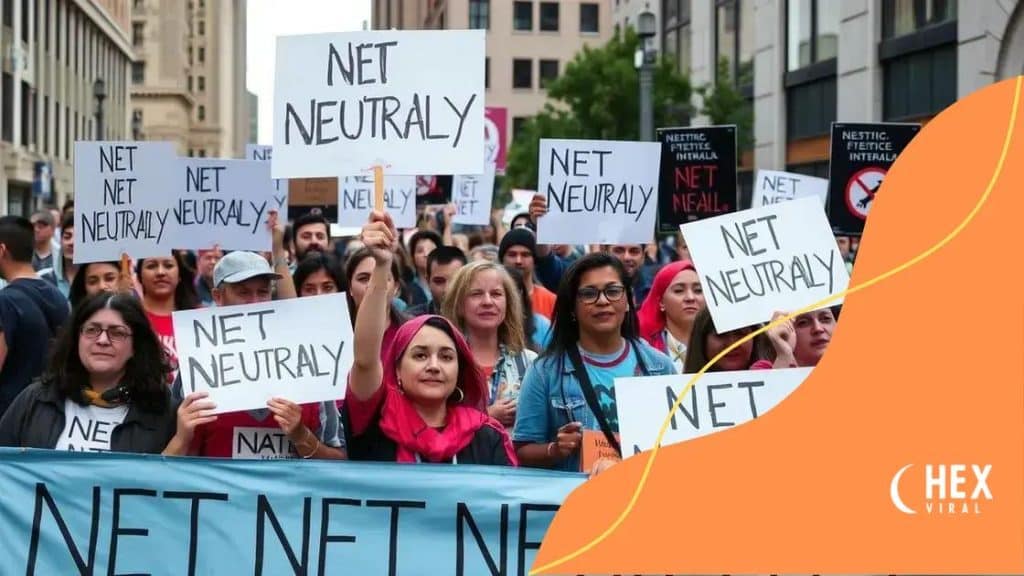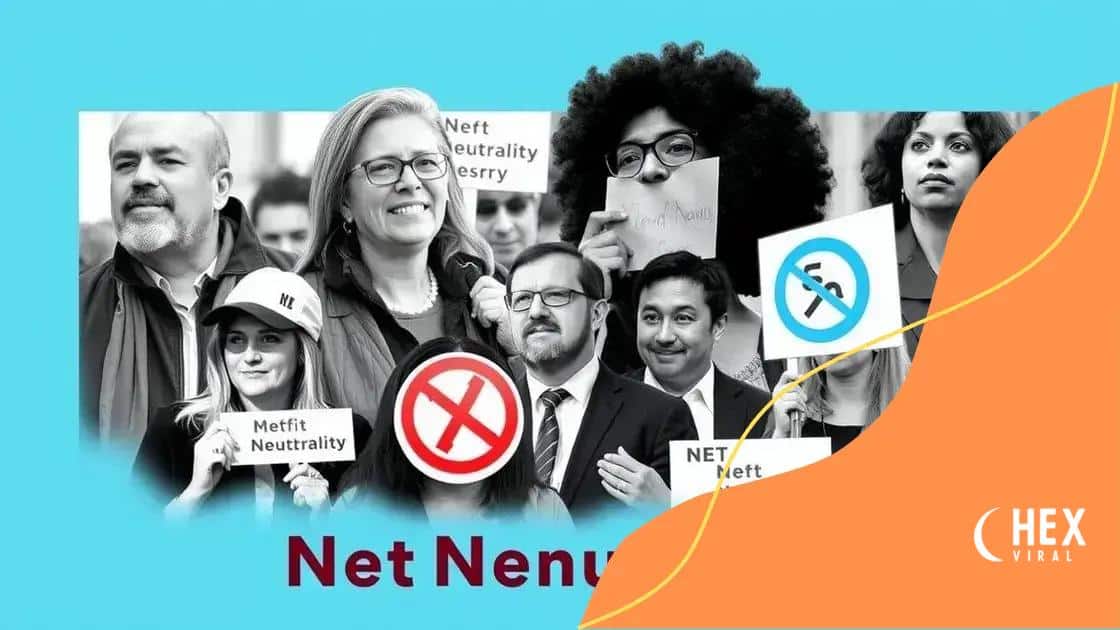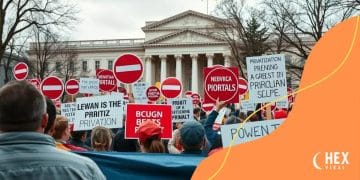Net neutrality advocacy protests: voices for equal access

Net neutrality ensures that all internet traffic is treated equally, allowing users to access all content without discrimination or preferential treatment from service providers.
Net neutrality advocacy protests have emerged as powerful movements aimed at preserving fair internet access for all. These events illustrate the public’s commitment to digital freedom, sparking conversations about equality online. Have you ever wondered how these protests shape the way we use the internet?
Understanding net neutrality
Understanding net neutrality is fundamental for anyone who uses the internet today. It involves maintaining an open internet where all data is treated equally, regardless of its source. This principle ensures that everyone has access to the same speed and quality of internet services.
When the rules of net neutrality are upheld, no internet service provider can favor one website over another. This means larger companies can’t pay for faster access, and smaller companies can compete fairly. Here’s why net neutrality matters:
The core principles of net neutrality
The core principles include:
- Equal access: All internet users should have equal access to all online content.
- No blocking: Internet service providers cannot block legal content from reaching users.
- No throttling: Providers shouldn’t slow down connections based on content type or source.
By understanding these principles, users can recognize the value of a free and open internet. This awareness can drive the ongoing discussions and policies around net neutrality.
The impact of net neutrality on users
Without net neutrality, the internet could become a less accessible place for many. Service providers might prioritize larger companies, leaving smaller businesses and startups at a disadvantage. This potential scenario raises questions about fairness in digital services.
Every internet user benefits when net neutrality is in place. It fosters innovation, allowing new ideas to flourish without the fear of exorbitant costs. Imagine how many apps and websites may not exist without the equal playing field that net neutrality provides!
The history of net neutrality protests
The history of net neutrality protests is a fascinating journey through time, reflecting the public’s desire for an open internet. Over the years, many individuals and organizations have taken a stand to ensure that internet access remains fair and equal.
The roots of these protests can be traced back to early debates about internet access. As the internet began to grow, concerns arose about how different service providers might manipulate access to various sites. This sparked the first major net neutrality protests.
Key events in net neutrality protests
Several significant events marked the history of net neutrality advocacy:
- 2006: Public outcry emerged after proposals suggested that providers might block or limit access to certain websites.
- 2010: The Federal Communications Commission (FCC) introduced rules to protect net neutrality; however, these regulations faced backlash and legal challenges.
- 2014: Major protests erupted when the FCC proposed allowing fast lanes that could favor large corporations, leading to widespread public demonstrations.
With social media and online platforms, these protests gained momentum, attracting supporters from diverse backgrounds. People rallied together to advocate for rules that protect the open internet, emphasizing that everyone deserves equal access.
In 2017, when the FCC voted to dismantle net neutrality regulations, protests intensified. Activists organized massive campaigns, reminding the public of the implications of losing net neutrality. The stakes were high, as many feared that without these protections, companies could control which information reached users.
Impact of protests on policy and awareness
The protests have contributed to increased public awareness about net neutrality and its importance. They showed how collective action can influence the conversation on internet rights and freedoms.
Many lawmakers began to recognize the necessity of protecting net neutrality and have proposed new legislation as a response. This history of activism demonstrates that the fight for equal internet access is ongoing and that every voice counts in preserving a fair and open internet for future generations.
Key figures in the net neutrality movement

Key figures in the net neutrality movement have played significant roles in shaping the conversation around internet access. These activists, politicians, and organizations have been instrumental in raising awareness and advocating for an open internet.
Individuals like Tim Berners-Lee, the founder of the World Wide Web, have emphasized the importance of net neutrality. He has warned against the dangers of allowing companies to control internet access, stating that it could disrupt the fundamental principles of the web.
Influential activists and their contributions
Many grassroots activists have also made a mark in this movement:
- Marvin Ammori: A lawyer and strong net neutrality advocate, Ammori has worked to educate the public about the implications of losing net neutrality.
- Rebecca MacKinnon: A co-founder of Global Voices, MacKinnon has spoken extensively about freedom of expression online and the need for protecting the internet.
- Jessica Rosenworcel: As an FCC commissioner, Rosenworcel has consistently fought for net neutrality and has pushed for policies that uphold its principles.
These individuals and many others have contributed to the broader discourse, showing that net neutrality is not just a technical issue but a matter of civil rights. Their work has mobilized people across the country to participate in protests and advocacy efforts, highlighting the need for a united voice.
Organizations advocating for net neutrality
Various organizations have also emerged as champions of net neutrality. Groups like Fight for the Future and Free Press have mobilized supporters to engage in campaigns focused on protection for internet users. Through petitions, rallies, and social media efforts, these organizations have made significant strides.
With a shared commitment to ensuring that the internet remains open and accessible, these key figures and groups have become vital as the net neutrality movement continues to evolve. Their ongoing efforts remind us of the critical importance of net neutrality for preserving an equitable digital landscape.
How protests influence policy changes
How protests influence policy changes is a critical aspect of the net neutrality movement. Protests serve as a powerful tool for raising awareness and creating pressure on lawmakers to act in favor of net neutrality.
When citizens come together to protest, they send a clear message to decision-makers. This grassroots activism can lead to substantial changes in policies and regulations. The voices of the people become too loud to ignore, often pushing representatives to reconsider their stance on crucial issues.
The role of public opinion
Public opinion plays a vital role in shaping policy changes. As more people understand the implications of losing net neutrality, their voices can sway politicians. Effective protests often attract media attention, which amplifies their messages.
- Media coverage: Coverage of protests can spark discussions and debates, allowing more people to learn about net neutrality.
- Social media mobilization: Activists use social media platforms to organize protests and share information, increasing visibility.
- Community engagement: Engaging with local communities helps educate individuals, empowering them to take action.
These elements combine to create a wave of public demand for policy reform. Lawmakers are more likely to support measures that protect net neutrality when they see strong public support and evidence of community engagement.
Case studies of successful protests
Many successful protests have led to meaningful policy changes. Notable examples include:
- 2014 Demonstrations: Protests against the FCC’s proposal to allow fast lanes resulted in an uptick in public support for net neutrality.
- 2017 Movements: Mass mobilizations in response to the repeal of net neutrality rules saw thousands of people contacting their representatives.
- Online campaigns: Websites and social media platforms rallied users to push for policy changes through petitions and direct outreach.
In each of these instances, the collective power of the people forced lawmakers to acknowledge the significance of maintaining an open internet for all. Protests continue to be a vital part of the strategy to ensure that net neutrality remains a priority in public policy discussions.
Future of internet access and net neutrality
The future of internet access and net neutrality is an evolving landscape that continues to impact every user. As technology advances, the conversation around net neutrality becomes increasingly important.
With the rise of 5G networks and other emerging technologies, there are both opportunities and challenges for maintaining an open internet. If policies are not carefully crafted, we could see a divided internet where only the wealthy can access faster services.
Emerging technologies and their impact
Technological advancements bring changes, and understanding their implications is critical:
- 5G Technology: This new standard can provide faster internet, but without policies to protect net neutrality, it could create fast lanes.
- Internet of Things (IoT): As more devices connect, users could face restrictions based on their service provider’s policies.
- Artificial Intelligence: AI can optimize data flow, but it could also raise concerns about privacy and data usage without proper regulations.
These technologies show promise, but they must align with the principles of net neutrality to ensure all users have equal access.
The role of legislation and advocacy
Legislators play a crucial role in shaping the future by introducing laws that protect net neutrality. Activism from groups such as Fight for the Future and Free Press remains essential in influencing policy changes. Their advocacy helps keep the conversation alive, ensuring that internet access remains equitable and just.
New proposals are constantly emerging, but public support is vital. When communities engage and advocate for their rights online, they can influence the decisions made at higher levels. Activism today sets the foundation for a more equitable internet tomorrow, where net neutrality remains a priority.
As we look to the future, it’s critical to remember that the fight for net neutrality is ongoing. Active participation in discussions surrounding internet access will shape how we interact with the digital world.
FAQ – Frequently Asked Questions about Net Neutrality
What is net neutrality?
Net neutrality is the principle that all internet traffic should be treated equally, without favoritism or discrimination.
Why is net neutrality important?
It ensures that everyone has equal access to information and services on the internet, preventing large companies from controlling what users can see.
How do protests impact net neutrality policies?
Protests raise public awareness and pressure lawmakers to support net neutrality measures, demonstrating that there is strong community support for an open internet.
What can I do to support net neutrality?
You can advocate for net neutrality by contacting your representatives, participating in campaigns, and educating others about its importance.






